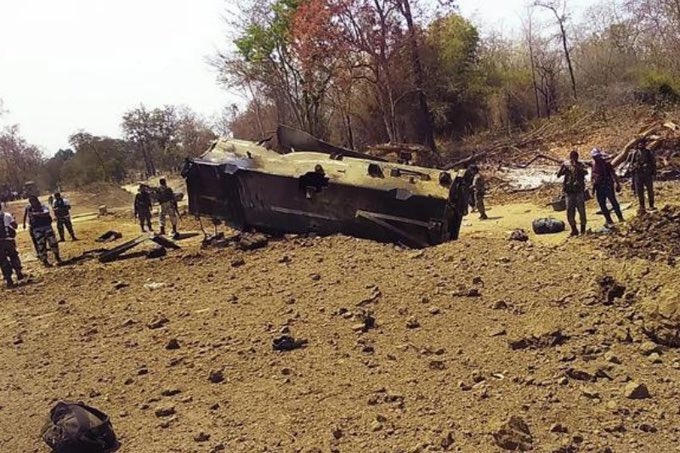In a tragic incident on January 6, 2025, Naxals ambushed security forces in Chhattisgarh’s Bijapur district, claiming the lives of eight District Reserve Guards (DRG) jawans and a civilian driver. The attack involved an improvised explosive device (IED) that targeted their vehicle, marking one of the most significant strikes on security personnel in the last two years.
Details of the Incident
The ambush occurred near Ambeli village under the jurisdiction of the Kutru police station. The DRG personnel were returning in a Scorpio vehicle after conducting an anti-Naxalite operation. The Naxalites detonated an IED, completely destroying the vehicle and leaving no survivors.
Inspector General of Police (Bastar Range) P. Sundarraj confirmed the details and stated that the incident highlights the persistent threat posed by left-wing extremists in the region.
📌 8 DRG Jawans and a driver, killed in IED blast triggered by Maoists in Bijapur, Chhattisgarh. #TNI #Insight #PiN pic.twitter.com/71riDy8129
— TNI (@TNITweet) January 6, 2025
Historical Context
This attack is reminiscent of a similar incident on April 26, 2023, in neighbouring Dantewada district, where ten police personnel and a civilian driver lost their lives to another IED explosion targeting a security convoy. Such incidents underline the ongoing challenges in combating Naxalite insurgency in Chhattisgarh’s Bastar region.
The District Reserve Guards (DRG)
The DRG, a specialized unit of the Chhattisgarh Police, is at the forefront of anti-Naxalite operations. Comprising personnel recruited from local tribal communities, the DRG plays a crucial role in counter-insurgency efforts due to its knowledge of the terrain and local dynamics. However, their operations also expose them to heightened risks, as evident in this latest tragedy.
Challenges and Implications
This incident reflects the persistent Naxalite threat in Chhattisgarh despite ongoing counter-insurgency measures. It also raises concerns about the safety and preparedness of security personnel operating in insurgency-hit areas. The use of IEDs by Naxals demonstrates their evolving tactics and the need for advanced technology and intelligence to mitigate such threats.
Government Response and Way Forward
The state and central governments have reiterated their commitment to eradicating Naxalite violence. Enhanced intelligence gathering, community engagement, and the modernization of security forces are vital to countering the insurgency effectively. Moreover, addressing socio-economic issues in affected areas remains a key component of the government’s strategy.
Conclusion
The loss of eight DRG jawans and a civilian driver in Bijapur is a grim reminder of the sacrifices made by security personnel in maintaining peace and security. This incident underscores the need for a comprehensive approach to combat Naxalism, combining robust security measures with socio-economic development initiatives to address the root causes of the insurgency.
This attack not only reflects the challenges on the ground but also the resilience of security forces dedicated to restoring normalcy in conflict-hit regions.
Additional Information
Government’s Efforts to Combat Naxalism
The Indian government has been actively pursuing a strategy to combat Left Wing Extremism (LWE), including in Chhattisgarh. In a recent meeting chaired by Union Home Minister Amit Shah, the central government committed to eliminating Naxalism by March 2026. This ambitious goal is part of the broader strategy to bring development to the tribal areas that have long been deprived of basic amenities and services due to the Naxal insurgency.
The Modi government has focused on a zero-tolerance approach toward Naxalism, strengthened infrastructure, and improved road, mobile, and financial connectivity in affected areas. Since 2019, the government has made significant strides in neutralizing Naxalite forces, with 237 Naxals killed, 812 arrested, and 723 surrendered in Chhattisgarh alone.
Security and Infrastructure Development
The security situation in LWE-affected areas has seen a notable improvement. From 2004 to 2014, only 66 fortified police stations were constructed, but the Modi government has increased this number to 544 in the last decade. Additionally, over 14,400 km of roads have been constructed, and 6,000 mobile towers have been installed to improve connectivity. These efforts have contributed to a reduction in violent incidents in LWE-affected regions by 53%, from 16,463 incidents between 2004 and 2014 to 7,700 in the last decade.
Challenges and Implications
Despite the significant improvements, Naxalism continues to hinder development in tribal regions. More than 8 crore people have been deprived of essential services such as education, healthcare, and basic infrastructure. Naxals’ use of IEDs and other violent tactics poses a persistent challenge to security forces operating in these regions. The attack in Bijapur serves as a stark reminder of the volatility in these areas.
Government’s Commitment to Development
The Modi government has also focused on the socio-economic development of LWE-affected areas. Efforts such as the ‘Dharti Aaba Janjatiya Gram Utkarsh Abhiyan’ aim to provide essential amenities like grains, medicines, schools, and health centers in remote tribal villages. This, combined with increased security and infrastructure development, is seen as a pathway to peace and prosperity in these conflict-ridden regions.
Disclaimer
This article is for educational purposes, focusing on the relevance of the topic for UPSC aspirants. Students should stay updated on further developments and refer to official sources for comprehensive preparation.
Follow Fusion IAS

